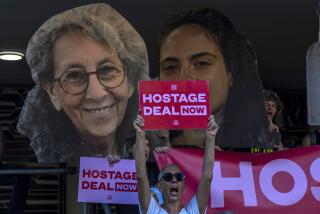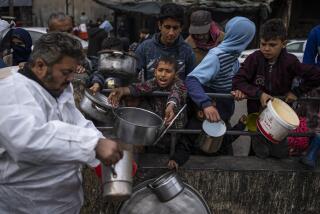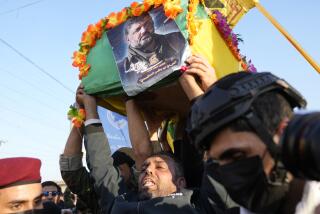Iraqi violence returns in force
- Share via
BAGHDAD — The four U.S. soldiers who died in a series of roadside bombings Wednesday lifted the number of American service members killed in April to a seven-month high of 50.
Civilian deaths reported by the Iraqi government also reached the highest levels in months as Baghdad experienced intense clashes triggered by an Iraqi government crackdown against Shiite Muslim militias.
U.S. commanders say Sunni Arab militants are also attempting to reassert themselves by staging suicide bombings and other high-profile attacks in parts of the country where they have come under pressure since last year.
The jump in deaths raises questions about whether U.S. and Iraqi forces can consolidate last year’s security gains as most of the additional 28,500 American troops deployed to the country return home.
“We have said all along this will be a tough fight,” said Army Maj. Gen. Kevin Bergner, a U.S. military spokesman. “There will be periods where we see the extremists, these criminal groups and Al Qaeda terrorists, seek to reassert themselves and reignite violence for their own purposes.”
U.S. commanders will be relying increasingly on their Iraqi counterparts to provide security as the American presence diminishes from a peak last year of nearly 170,000 to about 140,000 by July.
Navy Rear Adm. Patrick Driscoll, another military spokesman, said the Iraqis added more than 105,000 to their forces in the time the U.S. brought in five additional combat brigades.
“So we’ve seen a substantial surge within a surge, and they’re continuing to grow,” Driscoll said.
U.S. commanders say the Iraqi military and police are becoming more capable. Though they acknowledge that the government crackdown was poorly planned at the start, they say the Iraqi military quickly mobilized reinforcements and regained control of the southern oil hub of Basra with the help of U.S. and British air power.
But the government did not appear to have anticipated the fierce backlash from militiamen loyal to radical Shiite cleric Muqtada Sadr in Baghdad, where clashes continue daily.
Many of the militiamen’s attacks are directed against U.S. forces, who have moved into the southern portion of the cleric’s stronghold in the capital, the slum known as Sadr City, in a bid to stop rockets and mortar rounds from being fired toward the troops’ bases and the city’s fortified Green Zone.
U.S. soldiers in Sadr City have faced assaults by militiamen wielding rocket-propelled grenades on roads laced with bombs and have responded with airstrikes and tank fire.
The military says it makes every effort to avoid civilian casualties; however, residents are often caught in the crossfire.
The number of civilian deaths reported by the Iraqi government for April was 969, the highest since August, when 1,773 were recorded killed. At least 28 Iraqi soldiers and 69 policemen also were reported killed. Officials at two hospitals in Sadr City alone said they had received 321 bodies in the last month.
Prime Minister Nouri Maliki, a Shiite, lashed out Wednesday at the militiamen, whom he accused of using civilians as human shields. He vowed to disarm all militias, Sunni or Shiite.
“There is only one army, and that is the army of the state,” he told reporters at a news conference broadcast on state-run television.
A total of 354 suspected militants were killed and 1,270 arrested in Baghdad last month, according to government figures.
Sadr’s followers say they are being unfairly singled out while Maliki’s political allies are permitted to maintain armed wings. They accuse their Shiite rivals of using the crackdown to weaken the chances of Sadr’s followers in provincial elections scheduled for Oct. 1.
Two of the latest attacks against U.S. troops occurred in Baghdad, where three soldiers were killed in two bombings Wednesday. A fourth soldier was killed in a similar attack in Nineveh province, north of the capital.
The number of U.S. military deaths in April was the highest since September, when 65 U.S. service members were killed. In April 2007, 104 died, according to figures compiled by the independent website icasualties.org.
At least 4,063 U.S. personnel have been killed since the start of the Iraq war in March 2003, according to the site.
The level of violence has been inching up since January, after a 60% drop in attacks nationwide in the second half of last year, according to U.S. military figures.
Commanders attribute the 2007 drop-off to the U.S. troop buildup, the decision by tens of thousands of Sunni tribesmen and former insurgents to fight against extremists, and a unilateral cease-fire declared by Sadr in August.
Three of the additional combat brigades deployed for the buildup have returned home. U.S. commanders had been counting on Sadr’s truce to allow them to focus on keeping up the pressure on Sunni militants as more troops left.
That truce is in tatters since the crackdown against Shiite militias began March 25 in Basra, sparking an uprising by the cleric’s followers that quickly spread to Baghdad and other Shiite centers. The level of resistance in the overwhelmingly Shiite south dropped significantly when Sadr called his supporters off the streets five days after the crackdown began. But the fighting shows no sign of abating in Baghdad.
The U.S. military said it killed at least 23 gunmen in exchanges Wednesday in and around Sadr City, one of which lasted two hours. The district’s hospital officials said they had received 18 bodies and treated 31 people for injuries.
“Fighting in Sadr City is one of the main reasons for the spike in deaths this past month,” said Joost Hiltermann of the International Crisis Group. “That trend will continue, and the relative quiet accomplished by the surge [will] come to an end, if the U.S. does not reach a new understanding with the Sadrists.”
--
Special correspondents in Baghdad contributed to this report.
More to Read
Sign up for Essential California
The most important California stories and recommendations in your inbox every morning.
You may occasionally receive promotional content from the Los Angeles Times.










